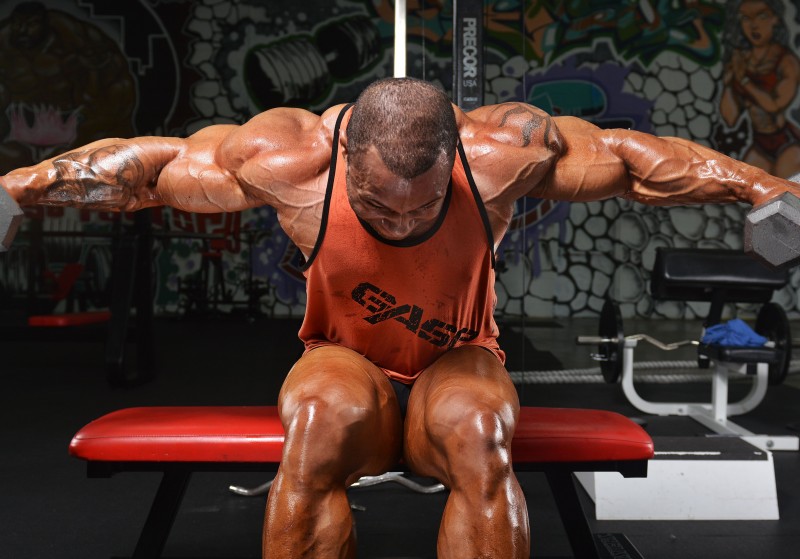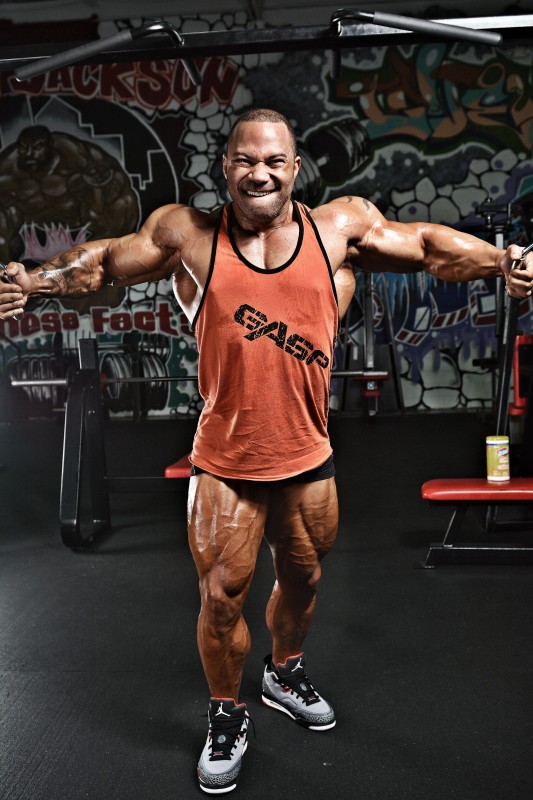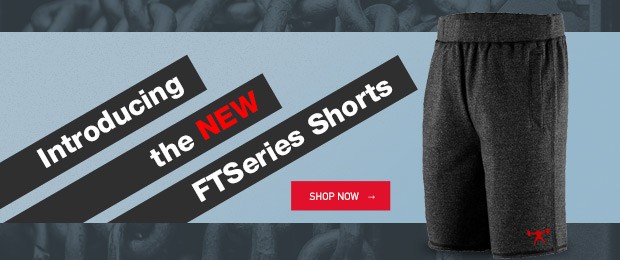
Working with John Meadows over the last three years, I’ve learned a multitude of new techniques relative to muscular growth, otherwise known as hypertrophy. Regarding the populations I’ve come to work with, I’ve developed a broader paradigm on the importance of muscularity and the training for it. My perspectives run counter to much of the current climate. I wrote this article not to say that everyone is “wrong” but to offer a different perspective. To preface, this isn't specifically directed toward powerlifters but the fitness industry at large.
Long-Term Considerations for Hypertrophy
Unlike the short-term perspective that currently dominates the training field, such as doing a “hypertrophy phase,” I've reframed hypertrophy training to be the predominant way to train over the long term. Why is this? Said simply, it's more sustainable. By training within the 6–20 rep ranges, one subjects the joints to less maximal stress over time. Additionally, and more importantly, muscle is likely the greatest preventative factor in degenerative aging. So it's crucial that you build and maintain it throughout your life. By training predominantly within the 10–20 rep range even, joint integrity can be maintained and strengthened even further, and by developing an individual's 10-rep max, his maximal strength potential continuously goes up without him ever needing to train maximally. For older athletes, keeping the weights “lighter” is less taxing on the joints and allows them to train long into their later years.
RECENT: Hypertrophy Is The Holy Grail
Counter to the current paradigm of “strength” training and the belief that muscle follows strength, my professional position is completely counter to this. Strength is ultimately an outcome of muscularity and the neuromuscular coordination of that muscle. Maximal strength is an outcome of submaximal training in which muscular coordination is increased over a period of time and then “peaked” to express that maximal level. What is the foundation of this strength though? Muscle and lean body mass or whatever you want to call it. Can you get stronger by training with low reps? Yes and no.
Low reps express strength built with lighter reps. Relative to long-term improvement in a sport such as powerlifting, lifting submaximal weights ensures greater longevity. If training at 78–80 percent allows you to train for 20 years and training at 80–95 percent means that you drop out after 10 years, who will be stronger in the end? I'll say that it's far more likely to be the former, not the latter.
Being Muscular is Being “Fit”
I've realized that the question of what is good “fitness” is an entirely nebulous one. Depending on the audience, you will get entirely different answers. Benchmarks associated with the squat, bench and deadlift do not correspond with decreased mortality or risk factors, nor do most “endurance markers” of fitness.
Relative to the state of medicine and exercise science, there are three things that have enough evidence to support a direct connection of relevancy to long-term health and decreased degenerative risk factors:
- Grip strength
- Lean body mass/muscle (generally the more the better, provided that one isn't excessively overweight)
- Cardiovascular stress test (To be overly reductionist, can you walk a 15-minute mile? If so, you are “healthy” by medical estimation.)
What accomplishes all the above? Habitual resistance training. I train my clientele for one thing—more muscle mass. That's it. Hypertrophy training can be structured in such a way as to improve body composition, cardiovascular function (although cyclical aerobic activity like walking and running has broader benefits) and work capacity as well as increase strength, kinesthetic awareness and lean body mass, all of which have a near endless list of health benefits.
Along with hypertrophy training, I encourage my clients to engage in aerobic activity, like walking, running and biking (but mainly walking). The health benefits associated with walking and LISS are nearly endless. Walking is entirely sustainable over a lifetime, barring disablement from injuries.
Damaged Joints Don't Build Muscle
What do I mean by this? Said simply, when a joint has been damaged at the level of the bone itself and/or is severely inflamed to the point that it hurts constantly, the muscles that surround and attach to that joint won't grow. This is purely observational on my part, but I also believe that the “science” would support it.
RELATED: Are You Training Enough to Build Muscle?
By my rationale, when joint integrity is compromised, why would the body add muscle tissue and subject that joint to more stress than it's already experiencing when it currently can't handle the demands already being placed upon it? For anyone who has ever suffered a severe joint injury or break, muscle loss is a very real phenomena that can happen. For anyone who has ever been in debilitating joint pain, it’s also well recognized that strength declines and musculature tends to decline with it.
What does this mean for hypertrophy though? The less joint stress that you incur in training and the greater muscular stress that you create, the more sustainable your training will be over the long term. This takes me to my next point.
The Less Joint Compression, the Better
I’ll say it first—I'm not advising people to never lift heavy but to rather make the insight that exclusively training heavy, or training heavy more than is necessary, isn't to your benefit. The term I like to use is “direct joint compression.” This refers to lifts that are particularly hard on the joints. The low back is the most notable, but this also applies to all the joints: the hips, shoulders, knees, elbows, wrists and ankles.
What movements are the most “joint compressive?” Largely the barbell movements. Barbell movements can obviously be loaded the heaviest, and they generally subject the joints to the highest levels of compression, torque and sheer force. Should they be avoided? No. But the frequency and intensity of which they are used over long periods of time is something that both older and younger lifters should be cognizant of.
Inexperienced trainees commonly attempt to train as heavy as possible for as long as possible. They also have a love affair with the barbell and want to use it for everything. While this doesn’t “not” work, it stops working at a certain point and creates the environment for injury beyond that. What causes this? Accounting for things like central nervous system fatigue, mental burnout and poor technique, there is also the rather simple physical factor that heavy barbell training is very stressful on the joints.
While Wolfs' Law states that bones remodel themselves (and they do), this isn't a continuously linear process. For long-term health and training longevity, the less “direct joint compression” on the joints, the better off you are.
What can be done? From an adaptation and programming perspective, the body and bones respond more favorably to slow changes in loading over time rather than constant upticks in resistance. An excellent example of this is the 5thSet Method. I recommend this constantly for people, and the program exemplifies this slow approach. You still train “heavy” but in a measured way that doesn't unnecessarily break you down. Progression is built on submaximal strength and muscle increases along with appropriate periods of peaking. This approach requires patience, but it reaps long-term dividends. From a training standpoint, the usage of specialty bars, dumbbell movements, machines and different forms of accommodating resistance (bands and chains) are all options to utilize.
Intermediate Angles Are Where “Growth” Lies
For anyone who has been around bodybuilders, at some point, you've heard the phrase “work all the angles” in regards to muscular growth. In the past two years, this concept has crystallized for me as far as how to achieve complete muscular development within a given muscle group.
Said simply, lines of movement are best thought of as a compass. You have north, south, east and west. You can squat, deadlift and overhead press to the north and south, and you can bench press and horizontal row to the west and east. But just those movements alone aren't enough to achieve maximum muscular potential for most people. It's the intermediate angles that need to be included.
What does this mean? For pressing, it's simple—low incline, mid incline and high incline pressing, or, using the compass metaphor, pressing northwest and southwest. For the back, you have high and low angled rowing variations so pulling northeast and southeast.
While the compass metaphor sounds complicated in the written word, it's one that I've found to be very effective with clients. Rather than remember anatomical lines of movement, you simplify exercises down to a directional mental model that they already have familiarity with.
For the lower body, it isn't quite as simple. It's helpful if you conceptualize the possible direction of the leg as its own compass. You can lunge forward, to the side, to the back and across. Relative to your training, if you spend most of your time simply squatting, you are in what I would consider a “north” position. So there is a likelihood that your adductors, glutes and hamstrings are underdeveloped. Some amount of lateral movement, posterior chain movement and single leg movement would benefit you.
Lest I be called insane for this, my recommendations strongly mirror what John Meadows recommends in Mountain Dog training with regards to finding different angles of growth to stress the muscle in novel ways and what Scott Stevenson recommends in Fortitude training as a means of achieving complete growth and maintaining structural balance. I’ll also give credit for the compass concept to Will Chung, a trainer, friend and mentor of mine.
Hopefully, the perspectives that I've shared are ones that make people think and reconsider their training in a different light. I'm learning all the time, and whether I'm right or wrong in all of this, I hope that passing it on to others helps them on their own journey through the iron.
Images courtesy of Jeffrey Sygo at www.symiphotography.com













As I get older I'm more concerned about my long-term health.
Things like eating 1 meal a day, keeping my weight down, having good cardiovascular health, and movement quality are a priority.
But that barbell keeps calling me.
You know that feeling of a heavy-ass barbell on your back or in your hands? Or grinding out a lockout with a squat that you thought was gonna staple you?
It's one of the few times you get to feel truly alive.